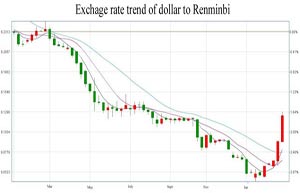China's bond market is projected to more than double within five years and account for 70 percent of the Asian bond market, a Boston Consulting Group report said.
The report predicts that by 2018, Asia's bond market will grow to 2.32 times its current size, or $16 trillion, and that China's onshore market will exceed Japan's to become the largest in the region.
According to Shanghai Clearing House, the amount of total bonds outstanding by the end of 2013 was 14.1 percent higher than that of the previous year, reaching 29.9 trillion yuan ($4.82 trillion).
|
 |
 |
BCG's projection means that China's bond market should increase 132 percent over the next five years, equal to a compound annual growth rate of 18.3 percent.
"We will see more Asian companies go directly to the bond market for financing in the following years as growth in bank financing cannot catch up with corporate financing demand," said Nick Gardiner, a partner of BCG and an author of the report.
He said that although Asia's bond market has doubled in size since 2009, momentum weakened due to a benign credit environment in which banks were less constrained in credit expansion.
"But now, many banks across the region have reached their ceiling in loan-to-deposit ratio. In addition, as we enter a new phase of the credit cycle, a lot of banks have begun to worry about asset quality," he said.
As the share of bank financing has fallen and domestic wealth has ballooned, an increasing number of insurance and pension assets are seeking local currency instruments that are secure and have a decent yield, further hiking the demand for corporate bonds.
BCG estimated that corporate bonds will account for 29 percent of the market by 2018, up from 11 percent in 2008. Local investors and banks will be the primary bond holders.
The growth of the region's corporate sector means many more companies will qualify for issuing bonds, Gardiner said.
"So you will get push from the issuers' side and pull from investors' side, which boosts the sector," he said.
The report noted that despite robust bond activity in Japan, South Korea and Hong Kong, Asia's overall bond market is still underdeveloped compared with mature economies. The size of the Asian bond market to total financing ratio stands at 18 percent, while the US' ratio is 52 percent and Europe's is 36 percent.
A separate report released by Australia's Center for International Finance and Regulation, noted that China's bond market is not only small in size but also lacks trading activities. Turnover (the number of times a bond is bought and sold per year) is only a fraction of that in the US. The US bond market is 10 times the size of China's, and its turnover is three times as high. China's market lacks liquidity as many bonds are held to maturity by banks and investment funds.
Moreover, relatively few bonds are traded on exchanges: 95 percent of transactions occur on the interbank over-the-counter market, where bonds are offered and purchased by banks and other qualified institutions "through inquiry and independent negotiations." As with other over-the-counter markets, such transactions lack transparency (transaction prices are not known to third parties), and counterparty risk may deter potential market participants.
|
 |
 |
